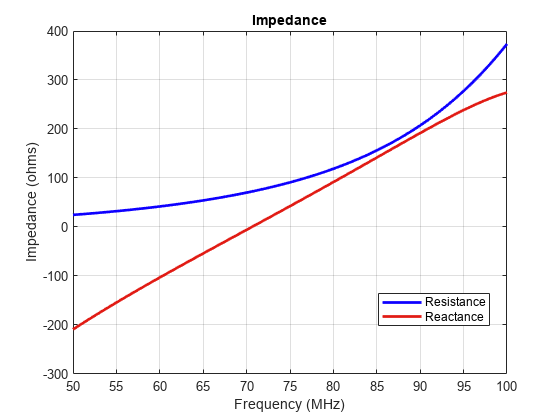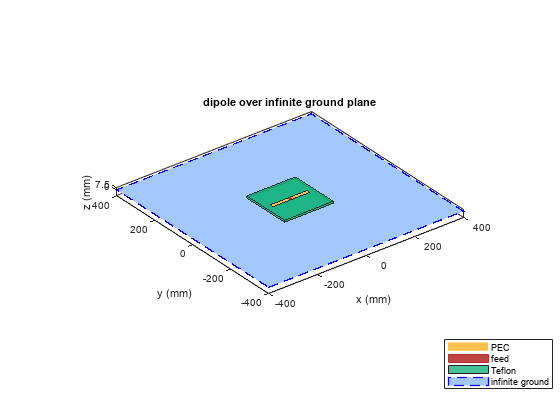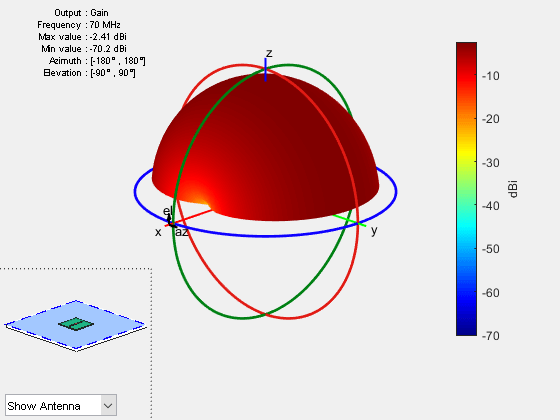dipole
Create regular or AI-based strip dipole antenna
Description
The default dipole object creates a strip dipole antenna
on the yz-plane, resonating around 70 MHz.
The width of the dipole is related to the diameter of an equivalent cylindrical dipole by the equation
where:
d is the diameter of equivalent cylindrical dipole.
r is the radius of equivalent cylindrical dipole.
For a given cylinder radius, use the cylinder2strip utility function to calculate the equivalent width. The
default strip dipole is center-fed. The feed point coincides with the origin. The origin
is located on the yz-plane.
You can perform full-wave EM solver based analysis on the regular
dipole antenna or you can create a
dipole type AIAntenna and explore the design
space to tune the antenna for your application using AI-based analysis.
Creation
Description
d = dipole
d = dipole(PropertyName=Value)PropertyName is the property name
and Value is the corresponding value. You can specify
several name-value arguments in any order as
PropertyName1=Value1,...,PropertyNameN=ValueN.
Properties that you do not specify, retain their default values.
For example, d = dipole(Length=4) creates a strip
dipole antenna with a length of 4 m. and default values for other
properties.
You can also create a regular
dipoleantenna resonating at a desired frequency using thedesignfunction. For example, to create a regulardipoleantenna resonating at 100 MHz, use the following syntax:To analyze this antenna use object functions of the>> design(dipoleHelix,100e6)
dipole. Use this workflow to design, tune, and analyze adipoleantenna using conventional full-wave solvers.You can create an AI-based
dipoleantenna resonating at a desired frequency using thedesignfunction. Using AI-based antenna models over conventional full-wave solvers significantly reduces the simulation time required to fine-tune the antenna to meet your design goals. Set theForAIargument in thedesignfunction totrueto create adipoletypeAIAntennaobject. To use this feature, you need license to the Statistics and Machine Learning Toolbox™ in addition to the Antenna Toolbox™. For example, to create an AI-baseddipoleantenna resonating at 100 MHz, use the following syntax:The AI-based>> design(dipoleHelix,100e6,ForAI=true)
dipoleantenna retains the Length and Width properties of the regulardipoleantenna as tunable properties. Rest of the properties of the regulardipoleantenna are converted into read-only properties in its AI-based version. To find the upper and lower bounds of the tunable properties, use thetunableRangesfunction.To analyze this antenna use object functions of the
AIAntenna. Use this workflow to design, tune, and analyze adipoleantenna using its AI-based model. To create a regulardipoleantenna from this AI-based antenna, use theexportAntennafunction.
Properties
Object Functions
axialRatio | Calculate and plot axial ratio of antenna or array |
bandwidth | Calculate and plot absolute bandwidth of antenna or array |
beamwidth | Beamwidth of antenna |
charge | Charge distribution on antenna or array surface |
current | Current distribution on antenna or array surface |
design | Create antenna, array, or AI-based antenna resonating at specified frequency |
efficiency | Calculate and plot radiation efficiency of antenna or array |
EHfields | Electric and magnetic fields of antennas or embedded electric and magnetic fields of antenna element in arrays |
feedCurrent | Calculate current at feed for antenna or array |
impedance | Calculate and plot input impedance of antenna or scan impedance of array |
info | Display information about antenna, array, or platform |
memoryEstimate | Estimate memory required to solve antenna or array mesh |
mesh | Generate and view mesh for antennas, arrays, and custom shapes |
meshconfig | Change meshing mode of antenna, array, custom antenna, custom array, or custom geometry |
msiwrite | Write antenna or array analysis data to MSI planet file |
optimize | Optimize antenna and array catalog elements using SADEA or TR-SADEA algorithm |
pattern | Plot radiation pattern of antenna, array, or embedded element of array |
patternAzimuth | Azimuth plane radiation pattern of antenna or array |
patternElevation | Elevation plane radiation pattern of antenna or array |
peakRadiation | Calculate and mark maximum radiation points of antenna or array on radiation pattern |
rcs | Calculate and plot monostatic and bistatic radar cross section (RCS) of platform, antenna, or array |
resonantFrequency | Calculate and plot resonant frequency of antenna |
returnLoss | Calculate and plot return loss of antenna or scan return loss of array |
show | Display antenna, array structures, shapes, or platform |
sparameters | Calculate S-parameters for antenna or array |
stlwrite | Write mesh information to STL file |
vswr | Calculate and plot voltage standing wave ratio (VSWR) of antenna or array element |
wireStack | Create single or multi-feed wire antenna |
Examples
References
[1] Balanis, Constantine A. Antenna Theory: Analysis and Design. Fourth edition. Hoboken, New Jersey: Wiley, 2016.
[2] Volakis, John. Antenna Engineering Handbook, 4th Ed. New York: Mcgraw-Hill, 2007.



